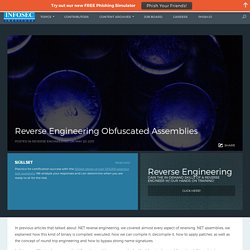

Reverse Engineering Obfuscated Assemblies. In previous articles that talked about .NET reverse engineering, we covered almost every aspect of reversing .NET assemblies, we explained how this kind of binary is compiled, executed, how we can compile it, decompile it, how to apply patches, as well as the concept of round trip engineering and how to bypass strong name signatures.

In this paper I’ll introduce you code obfuscation and how we can deal with obfuscated assemblies when talking about reverse engineering. As previously said (for more information please check the references section), every high level .NET based language is translated to the same low level language which is the Common Intermediate Language. With the help of some tools, we can easily translate this low level language to any high level one that should embarrass any software vendor, because at this point we are not talking about protecting a software from being tampered or reverse engineered; we are talking about protecting the whole source code of our work.
Patching .NET Binary Code with CFF Explorer. Abstract The purpose of this article is to show how to bypass various security checks by modifying binary code directly, rather than source code, through the use of CFF Explorer.

We have already looked at the diverse ways of circumventing IL code earlier. There we have accomplished such crucial tasks by playing with IL byte code instruction. This article basically teaches you how to identify the corresponding binary code instructions using the IL disassembler; then you will learn how to modify such binary code (hex code) using an editor such as CFF Explorer. Prerequisites It is presumed that the user has a thorough understanding and knowledge of binary coding manipulation and that you have installed a fresh copy of CFF Explorer software in order to edit the binary code instructions. .NET Assembly Programming. .NET Reverse Engineering-1:CIL Programming. .NET Reverse Engineering –Part 2. Introduction The first Article of this series touched the most significant aspect of the MSIL code Instructions, for instance, how a program written in ILASM, and how to define the basic components (classes, fields, function and methods).

In this article, we will continue working with IL code various data type, opcode instructions and learn remaining sophisticated features (Interface, Boxing, and Branching) of the runtime and ILASM. We’ll get to an understanding of details analysis of each opcode instruction and, how to integrate an IL code into an existing high-level C# written code and how to convert an already built C# code into IL code directly, in order to free the programmer from writing complex IL instruction code. CIL Data Types CIL also has the provision of data type like other high level languages in order to map the data into their specific compartment. MSIL Code Labels ILDASM /Token test.exe This command produces the corresponding Token information with IL_XXXX as:
.NET Reverse Engineering – 3. Introduction We have taken tour of the syntax and semantics of raw CIL up till now.

In this article, we shall be confronted with the rest of implementation in the context of CIL programming such as how to build and consume *.dll file components using MSIL programming opcodes instruction set. Apart from that, we will see how to integrate exception handling related opcode instruction into IL code in order to handle unwanted thrown exception. Finally, we’ll come across with some unconventional methods of inline IL programming by integrating its opcodes into existing high level language source code. Building and Consuming *.DLLs files DLLs (Dynamic Linking Library) files are deemed to library components of business logics for future reusability. Here the following code, defines two methods Hello() which simply displays a passed string over the screen and second method Addition() takes two integer values in order to calculate their sum as following: Building DLLs File.
Extreme .NET Reverse Engineering - 4. Extreme .NET Reverse Engineering - 5. Reverse Engineering with Reflector: Part 1. Abstract This paper intended to teach sophisticated reverse engineering tactics, mainly by using Red Gate Reflector.

This article demystifies dissembling and cracking of .NET binaries, step by step, in order to reveal protected targets with confidential information. That includes finding entry points, license keys, passwords, and serial keys. .NET reversing with Reflexil. Technically speaking a .NET built software or component (DLL) resembles an executable assembly.

That’s because it’s compiled in MSIL, and you can usually view the source in Reflector and many other tools such Ispy. But when it comes to commercial software, more and more complicated protection mechanisms are being implemented to shield them. After analyzing many products, I discovered so much about how all these components share to protect themselves. My motive to write this paper is that I couldn’t find any papers on this topic in detail. That’s because hackers are still not interested in this platform yet.
This article illustrates these topics in detail: Reflexil Installation and ConfigurationEncountering with ReflexilThe VictimReversing Tutorial (Patching the Binary)Final Note Reversing is impossible without the using appropriate tools. In the context of .NET, the modification of software methods with MSIL at runtime is captivating. Prerequisite Reflexil Installation and configuration.